 Use Google Maps, Workspace, Fitbit and Pixel to hit your running goals in 2023.
Use Google Maps, Workspace, Fitbit and Pixel to hit your running goals in 2023.
13 tips to help you start running in 2023
 Use Google Maps, Workspace, Fitbit and Pixel to hit your running goals in 2023.
Use Google Maps, Workspace, Fitbit and Pixel to hit your running goals in 2023.
 Use Google Maps, Workspace, Fitbit and Pixel to hit your running goals in 2023.
Use Google Maps, Workspace, Fitbit and Pixel to hit your running goals in 2023.
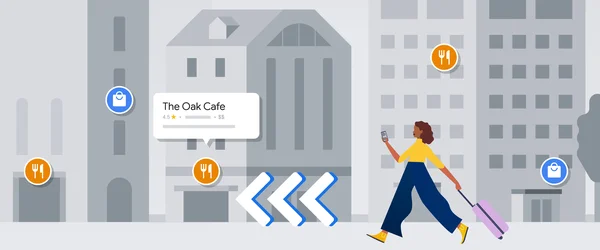 Announcing the launch of immersive view, updates to Live View, new EV charging tools, and glanceable directions on Maps.
Announcing the launch of immersive view, updates to Live View, new EV charging tools, and glanceable directions on Maps.
 Make the eco-friendly choice, the easy choice with updates you may have missed this year from Maps, Flights, Search and Pixel.
Make the eco-friendly choice, the easy choice with updates you may have missed this year from Maps, Flights, Search and Pixel.
 The Gorillaz band re-invents the music video and concert going experience using ARCore Geospatial API.
The Gorillaz band re-invents the music video and concert going experience using ARCore Geospatial API.
“Kwentuhan” roughly translates to “sharing stories” in English. For Filipino American History Month, or Kapamilya Month as our Filipino Googler Network refers to it, we sat down with Paolo Malabuyo, Director of User Experience in Google Maps and executive sponsor of the Filipino Googler Network, to learn about his story.
As a child growing up in the Philippines, we heard you were somewhat of a Lego competition legend. How did this kickstart your interest in working in UX and design?
I was the youngest of four and I always felt like I was in the shadow of my older, smarter, more athletic and more accomplished siblings. I don’t recall having many ideas about what I wanted to be when I grew up, until my grandmother immigrated to the United States in the 1960s and started sending small handfuls of Lego pieces through the mail.
This started my fascination with Lego and culminated in my participation in Lego competitions across the Philippines. I still think that the greatest job in the world is designing Lego sets.
I immigrated to the States right before my 12th birthday and picked up drawing, reading, and crafting. This developed into a real affinity for art. I ended up getting a BFA in art and minors in communication design, art history and Chinese studies. I also took basic programming classes and learned web design by emulating early websites.
Like Lego pieces, my early days of creatively building, combined with my art education and CS study were what constructed my career today. I got my first role as a graphic designer which started my roundabout journey to become a UX designer, leader and educator.
Can you talk about your role at Google?
I lead the cross-disciplinary user experience teams for Geo Auto and Geo Sustainability. In Auto, we design and deliver the in-car, embedded Google Maps experiences for navigation, routing, and situational awareness so that drivers are safer and more confident, with a major focus on electric vehicles. In Sustainability, we provide platforms, insights, and solutions that help users and partners tackle climate change – the preeminent challenge for humanity today. It’s an incredibly interesting portfolio and it’s such a privilege to work with our teams and clients.
As an executive sponsor for the FIlipino Googler Network, I get to work closely with other teams across Google on projects that impact the Filipino community. One example is the work happening on Maps to help business owners identify themselves, including the introduction of the Asian-owned attribute earlier this year. This attribute will help many Filipino businesses be recognized by current and future customers.
What else is Google doing in support of Filipino culture?
It’s great to see how Google’s products and services are celebrating Filipino culture and elevating our voices. This month, we ran a beautiful Google Doodle in the Philippines which celebrated the Regatta de Zamboanga, an annual sailing competition from the southern part of the country.

Google TV is highlighting recent movies and TV shows that tell Filipino American stories and feature Filipino American lead actors in its “For you” tab.

One of Google TV's highlighted shows for Filipino American History Month
And Google Arts & Culture has teamed up with amazing organizations to celebrate the rich culture and history of the Philippines, including the Filipinas Heritage Library, Filipino Street Art Project, and the Ballet Philippines.
Earlier, you talked about how you grew up in the Philippines. What role do you think Google has to play in supporting the local community?
Google has amazing resources that can help the people in the Philippines. We’ve done a lot to support inclusive distance learning, from a Google.org grant to help teachers, to the national deployment of G Suite for Education to 22 million learners in partnership with the Department of Education. We’re collaborating with local telecommunications companies to bring mobile access to learning tools and started a virtual training camp for Filipino YouTubers to accelerate development of quality learning content on the platform. Just last month, we announced we will be giving away Google Career Certificate scholarships to 39,000 Filipino youths.
Commitments like these are super valuable, and I’m grateful for the work to come.
“Kwentuhan” roughly translates to “sharing stories” in English. For Filipino American History Month, or Kapamilya Month as our Filipino Googler Network refers to it, we sat down with Paolo Malabuyo, Director of User Experience in Google Maps and executive sponsor of the Filipino Googler Network, to learn about his story.
As a child growing up in the Philippines, we heard you were somewhat of a Lego competition legend. How did this kickstart your interest in working in UX and design?
I was the youngest of four and I always felt like I was in the shadow of my older, smarter, more athletic and more accomplished siblings. I don’t recall having many ideas about what I wanted to be when I grew up, until my grandmother immigrated to the United States in the 1960s and started sending small handfuls of Lego pieces through the mail.
This started my fascination with Lego and culminated in my participation in Lego competitions across the Philippines. I still think that the greatest job in the world is designing Lego sets.
I immigrated to the States right before my 12th birthday and picked up drawing, reading, and crafting. This developed into a real affinity for art. I ended up getting a BFA in art and minors in communication design, art history and Chinese studies. I also took basic programming classes and learned web design by emulating early websites.
Like Lego pieces, my early days of creatively building, combined with my art education and CS study were what constructed my career today. I got my first role as a graphic designer which started my roundabout journey to become a UX designer, leader and educator.
Can you talk about your role at Google?
I lead the cross-disciplinary user experience teams for Geo Auto and Geo Sustainability. In Auto, we design and deliver the in-car, embedded Google Maps experiences for navigation, routing, and situational awareness so that drivers are safer and more confident, with a major focus on electric vehicles. In Sustainability, we provide platforms, insights, and solutions that help users and partners tackle climate change – the preeminent challenge for humanity today. It’s an incredibly interesting portfolio and it’s such a privilege to work with our teams and clients.
As an executive sponsor for the FIlipino Googler Network, I get to work closely with other teams across Google on projects that impact the Filipino community. One example is the work happening on Maps to help business owners identify themselves, including the introduction of the Asian-owned attribute earlier this year. This attribute will help many Filipino businesses be recognized by current and future customers.
What else is Google doing in support of Filipino culture?
It’s great to see how Google’s products and services are celebrating Filipino culture and elevating our voices. This month, we ran a beautiful Google Doodle in the Philippines which celebrated the Regatta de Zamboanga, an annual sailing competition from the southern part of the country.

Google TV is highlighting recent movies and TV shows that tell Filipino American stories and feature Filipino American lead actors in its “For you” tab.

One of Google TV's highlighted shows for Filipino American History Month
And Google Arts & Culture has teamed up with amazing organizations to celebrate the rich culture and history of the Philippines, including the Filipinas Heritage Library, Filipino Street Art Project, and the Ballet Philippines.
Earlier, you talked about how you grew up in the Philippines. What role do you think Google has to play in supporting the local community?
Google has amazing resources that can help the people in the Philippines. We’ve done a lot to support inclusive distance learning, from a Google.org grant to help teachers, to the national deployment of G Suite for Education to 22 million learners in partnership with the Department of Education. We’re collaborating with local telecommunications companies to bring mobile access to learning tools and started a virtual training camp for Filipino YouTubers to accelerate development of quality learning content on the platform. Just last month, we announced we will be giving away Google Career Certificate scholarships to 39,000 Filipino youths.
Commitments like these are super valuable, and I’m grateful for the work to come.
When I was 5, our family moved from New York City to the countryside outside of the city. My brother and I were the only kids of Asian descent in our elementary school. Our father was born in Yamaguchi, Japan to a Japanese mother and American father, and I always felt proud of that — but in this new environment, I instantly felt different.
These early experiences showed me just how important it is to show up for and with communities. Over the past two years, COVID-related small business closures and targeted acts of violence have reinforced the importance and impact of allyship — and have underscored how critical it is to support historically marginalized communities, including our Asian community. That’s why we’re announcing a new way to help Asian-owned businesses thrive.
Starting today, US businesses can now add the Asian-owned attribute to their Business Profile on Search and Maps. In the coming weeks, ad-supported publishers will be able to identify as Asian-owned in Display & Video 360’s Marketplace, too.
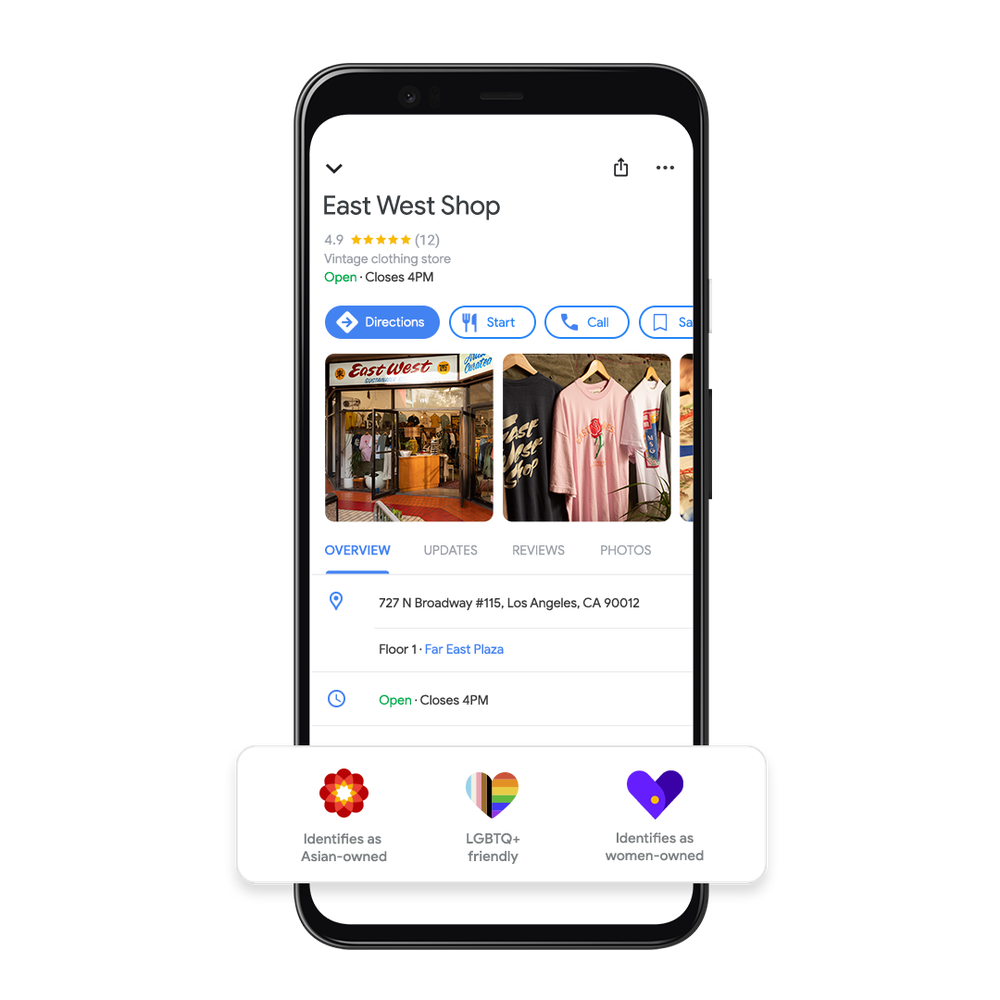
Businesses can opt in to adopt the attribute on their Business Profile and can easily opt out at any time. Once the attribute appears on a Business Profile, users will also be able to see the attribute. This update builds on the Black-owned, Latino-owned, veteran-owned, women-owned andLGBTQ+ owned business attributes, and is another way people can support a diversity of businesses across Google’s products and platforms.
As we were building this feature, we worked with hundreds of Asian-owned businesses to ensure the attribute celebrates our diverse and unique cultures. During that process, I was particularly struck by what Dennys Han, owner of East West Shop, shared with us about the power of community: “If someone is trying to accomplish something, the entire local Korean community will band together to help it come together. The idea of the community and group as a whole uplifting each other is fundamental to what we do.”
Over the past few years, Grow with Google has partnered with the US Pan Asian American Chamber of Commerce (USPAACC) to help Asian-owned small businesses grow. To date, we’ve helped more than 20,000 Asian-owned businesses expand their digital skills through workshops focusing on topics like e-commerce tools, design thinking for entrepreneurs and making decisions using analytics.
Today, we’re building upon that partnership. Together, USPAACC and Grow with Google will help an additional 10,000 Asian-owned small businesses gain digital skills to help them grow their businesses. And as the internet continues to grow in importance for shopping, nearly one quarter of Asian-owned business owners said their most important channel towards building community and financial support was across social media and online.
It’s our hope the Asian-owned attribute brings people together and provides our communities with much-needed recognition: to help them be seen and thrive. We are excited to spotlight Asian-owned businesses and highlight part of what makes our community unique and important.
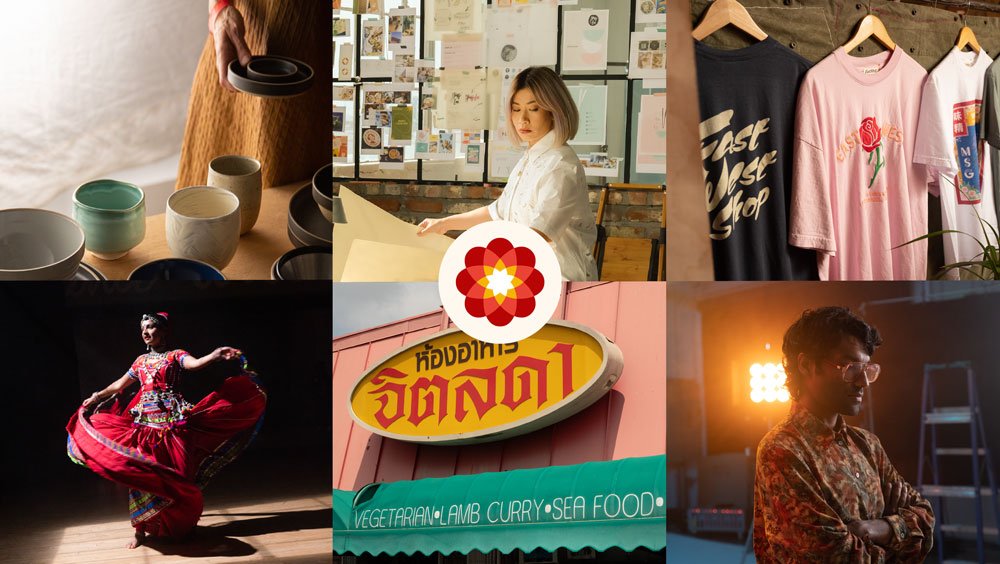
Top left to right:
Tortoise General Store, Owned by Taku and Keiko Shinomoto
Good Hause, Owned by Brittany Tran
East / West Shop, Owned by Dennys Han
Bottom left to right:
Bollypop, Owned by Aakansha Maheshwari
Jitlada, Owned by Sugar Sungkamee
Peru Films, Owned by Tanmay Chowdhary
Based in Zürich, Lisa is Product Partnerships Manager for Maps. She helps partners to integrate their charging station locations into Google Maps, which makes recharging as seamless as possible for e-drivers.
And by seamless, she means that charging should be as easy, safe and reliable as it is with petrol- or diesel-powered cars.
She grew up in a small village near Schwerin, where she still goes to unwind. "There were no buses there. Just one empty street and maybe 20 houses. It's the kind of place where you had to make do with a bicycle," she says.
She doesn't even own a car. "In Zürich, you just don't need one." But today, she owns three bicycles: "A mountain bike for taking a spin in the countryside, a fast racing bike and an old city bike that I won't miss if it gets stolen", she says, laughing.
Lisa is always looking for the best way to get around — not just in her free time, but also at work.
The first big step was to display charging stations on Google Maps, making it easier for drivers to find the nearest charging station. The next step is smart route planning, which Volvo, for example, has already integrated into its vehicles.
We want to make charging electric cars as easy and reliable as possible
Travel has become a recurring theme in Lisa's life. On her journeys around the world, she always enjoyed finding her own routes and choosing the best options. But she says there was always a bigger question on her mind: How can we improve mobility? Not just for individuals, but for everyone.
Four years ago, Lisa took inspiration from the climate strikes organized by Greta Thunberg, and realized it was time to act. "The next generation is clearly telling us what they want from us. And they want it now." This growing movement changed the way people look at electric vehicles.
At the same time, Google Maps created a new global division with a whole range of experts and introduced the first electric vehicle (EV) feature on their maps. In 2020, the first fully integrated solution was created in collaboration with Polestar and Volvo, which developed an electric car with Google Assistant, Maps and Play built into its system.
Several major car manufacturers are now collaborating with Google to offer all-in-one solutions like this.
More and more drivers are now benefiting from the work that Lisa and her team are doing. According to the latest Global Electrical Vehicle Outlook report, in 2021 nearly 10% of global car sales were electric, which is four times the market share in 2019. This brought the total number of electric cars on the world’s roads to about 16.5 million, triple the amount in 2018. Sales in Europe showed robust growth (up 65% to 2.3 million) after the 2020 boom. And at the same time, more and more car-sharing providers and public transport companies are investing in e-mobility or planning to transition in the near future.
Discussions are already taking place to see how Google and Lisa's team can support them along the way. Lisa's number-one priority for the future is to expand the project globally. She and her team have already come a long way by creating a practical online atlas for electric vehicle charging stations. Yet there are countless other ways to make mobility more sustainable in the future.
I once read that the happiest part of traveling is the planning, and I couldn’t agree more. Before I board a plane, I spend hours researching and documenting the what, where and how of my vacation. Over the past two years I’ve traveled far less than usual, but this year my husband and I decided to go to Italy. It was our first time there, and one of our biggest trips since COVID hit, so I took prepping to a new level. Here’s how I, a self-proclaimed travel nerd, used Google tools to get ready for my getaway.
About a month before our trip, I realized we’d done it all wrong. We weren’t going to have enough time to go hiking, and we were adding unnecessary hours of driving — and with increasing gas prices, that would end up costing way too much. Telling your travel partner you want to start over mere weeks before your trip is tough, and I knew I needed to really sell it…so I made a Google Slides presentation.
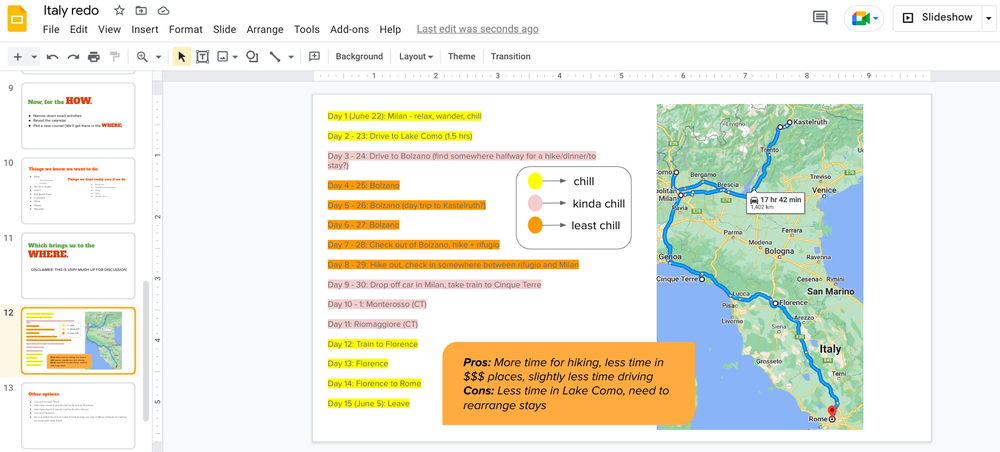
One of the many slides I used to convince my husband we needed to replan our trip.
I’ve used Slides for vacation planning in the past, too — and not just to blow everything up and start over. I’ve also presented what I’ve learned about various travel destinations we’re considering to make a decision. This helps me think clearly about what I want out of a vacation; it feels a bit like I’m vision-boarding the potential trip. And apparently it’s a great selling point, because my husband was completely on board by the end of the presentation.
2. Go off the beaten path with Google Maps.
I often find myself aimlessly “wandering” around Google Maps and Street View, looking for unusually shaped peninsulas or clicking into 360-degree photos that seem impossible to have captured. It’s a great way to cure wanderlust from home, but it’s also an effective way to plan travel. This was how I found a few of our stops in Italy.
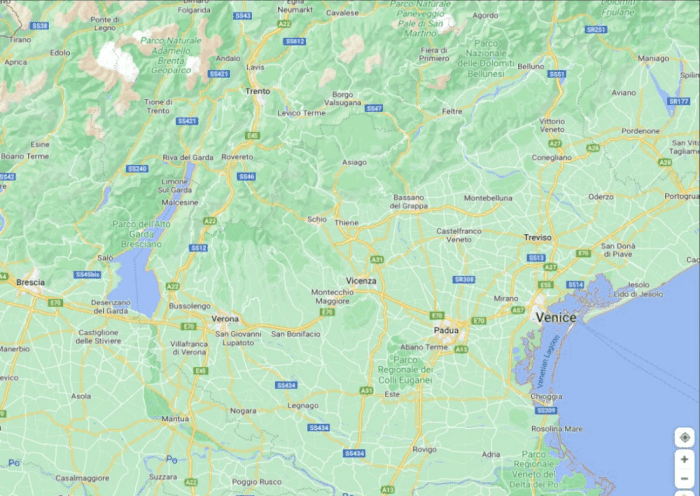
A little Google Maps “wandering” led me to the town of Sirmione. It caught my eye because it’s basically an island in Italy’s Lake Garda: A narrow road connects Sirmione to the mainland; it’s so tiny that most people park on one side and walk over to the rest of the city, going by foot or golf cart.
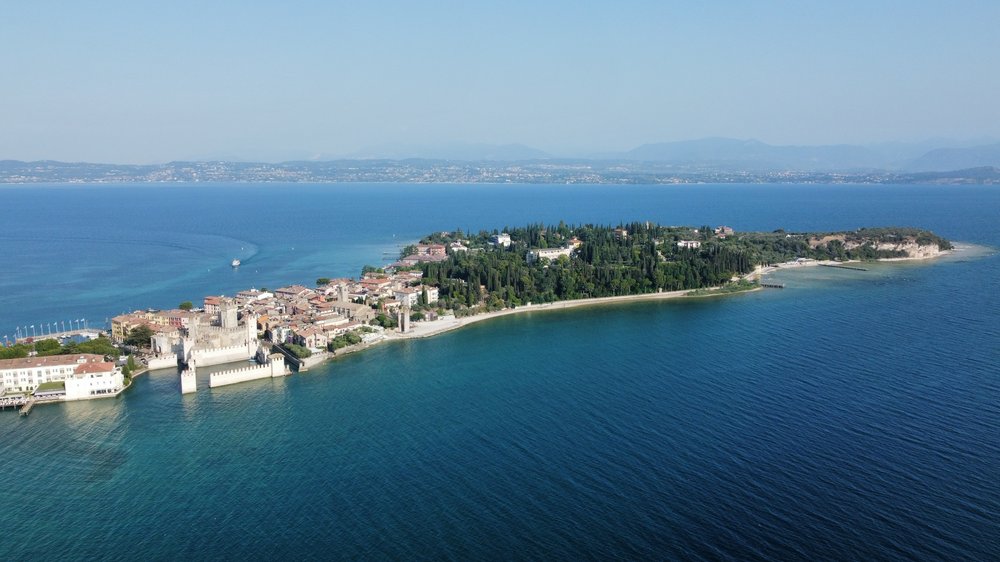
An aerial shot of Sirmione taken by my husband.
It’s a place I’ve never heard of, and likely never would have gone.
This is also how we found one of our favorites hikes. The Dolomites are massive — choosing where to visit was overwhelming. But my husband noticed an interesting looking area on Google Earth called Seceda (the fact that it was labeled “Seceda famous view” on Google Maps didn’t hurt our interest either). That was enough for us to add it to our itinerary, and I couldn’t be happier that we did — see for yourself.
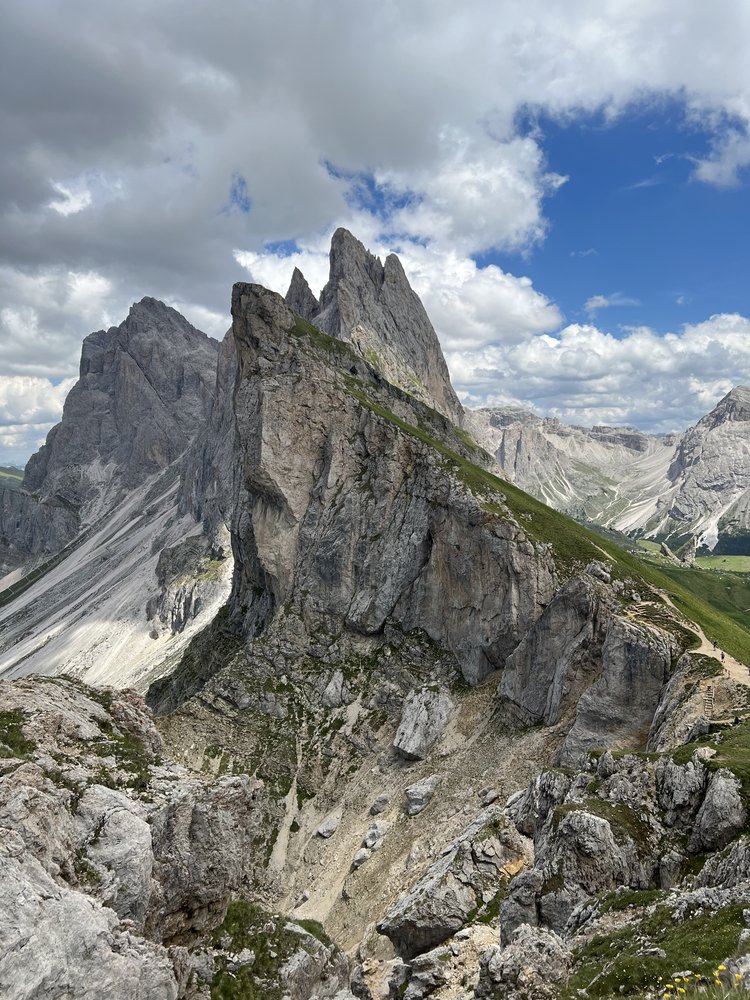
3. Take organization to another level with Google Sheets.
Using Google Sheets to organize various parts of a trip is admittedly very obvious compared to my first two tips, but here’s how I like to set things up: I have three pages in a Sheet file — one that functions as a list of things to do in each location, one that lists all of our reservation information and a last tab to collect expenses as we accumulate them while planning and during the course of the trip.
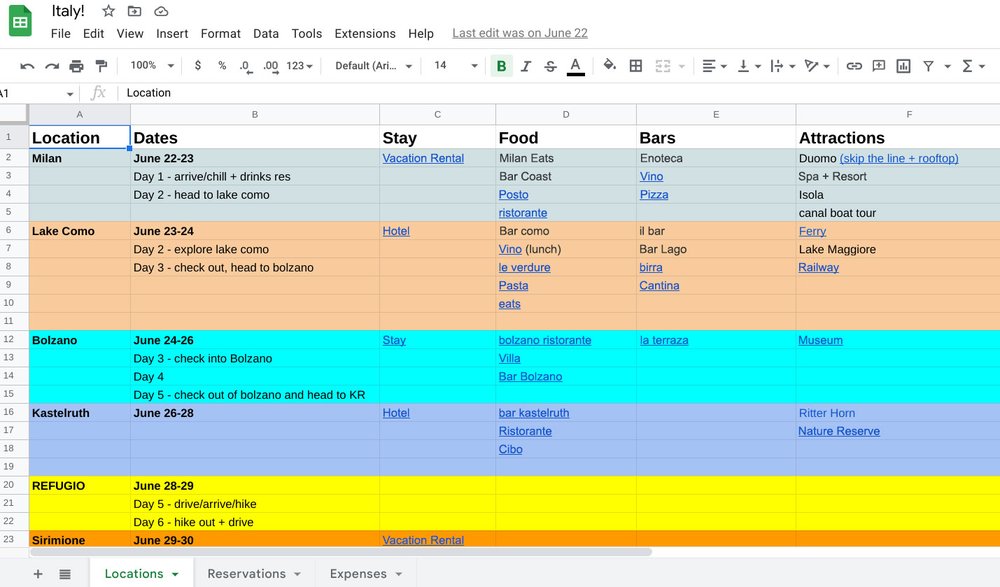
I like to think of everything listed on this first tab as something potentially worth checking out versus something that’s set in stone. This way, we don’t have to waste time while there looking things up — now if we’re ever wondering “what should we do here?” we can turn to the list for quick, easy access to already researched options.
4. Hit the Search bar…and then the Save button.
I’ve always found it easy to find amazing restaurants and shops when I want to travel, but not quite as simple to grasp what the best outdoor areas are — I want to find the best spot for a sunset, or a viewpoint for an afternoon walk. I’ve found more than a few breathtaking sights by heading to Search and simply entering the name of the city I’m visiting. On the right-hand side, there’s a Knowledge Panel about the location with information like the weather, elevation and local time. Below this is a section that says “Plan a trip,” and underneath that a camera icon next to the words “Things to do.”
And that is how I found arguably the cutest landmark in existence, this “Kiss…Please” sign in Sirmione.

I saved the location straight from this panel so it automatically saved to google.com/travel, and we easily found it when we stopped in the city.
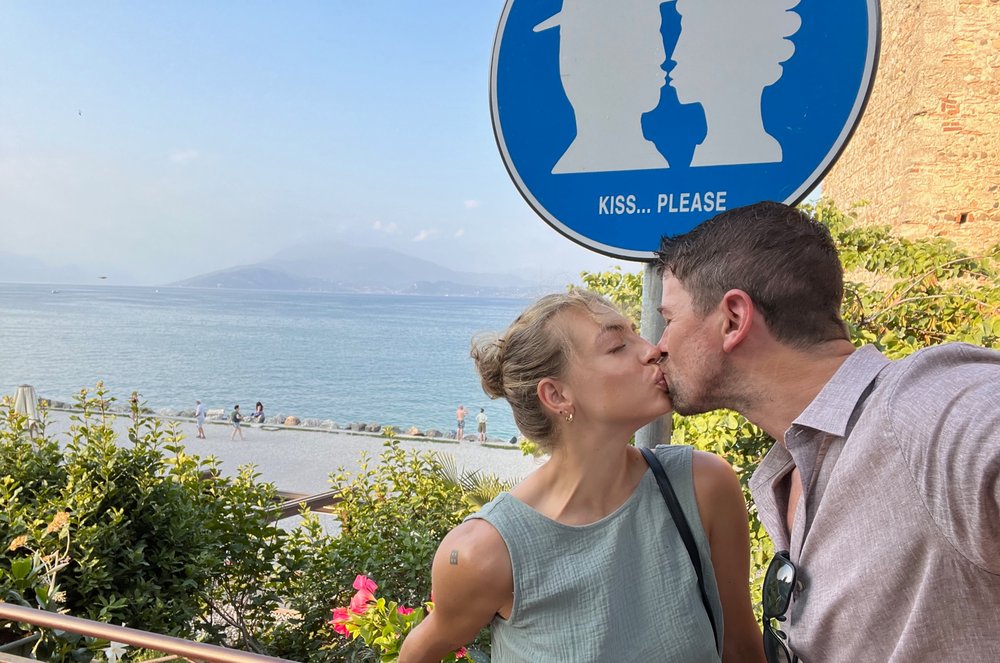
We had to!
5. Stay on budget with a bunch of Google tools.
Traveling is expensive, and while this was definitely a trip we planned and saved for, we were very conscious of not exceeding our budget. I used three Google tools to help us do that. First up, Google Flights. Ahead of buying our flights, I created various alerts to airports in Italy to find the best price and timing. (I also used this feature to price hotels.) Then, while we were there, we used Google Maps’ toll feature, so we could avoid more expensive routes. And of course, there’s the aforementioned Google Sheets tab to collect expenses.
All of these things helped me plan (and thoroughly enjoy planning) my trip — and obviously enjoy the trip itself. Whenever you take your next vacation, hopefully these tips are just as useful for you.
I once read that the happiest part of traveling is the planning, and I couldn’t agree more. Before I board a plane, I spend hours researching and documenting the what, where and how of my vacation. Over the past two years I’ve traveled far less than usual, but this year my husband and I decided to go to Italy. It was our first time there, and one of our biggest trips since COVID hit, so I took prepping to a new level. Here’s how I, a self-proclaimed travel nerd, used Google tools to get ready for my getaway.
About a month before our trip, I realized we’d done it all wrong. We weren’t going to have enough time to go hiking, and we were adding unnecessary hours of driving — and with increasing gas prices, that would end up costing way too much. Telling your travel partner you want to start over mere weeks before your trip is tough, and I knew I needed to really sell it…so I made a Google Slides presentation.

One of the many slides I used to convince my husband we needed to replan our trip.
I’ve used Slides for vacation planning in the past, too — and not just to blow everything up and start over. I’ve also presented what I’ve learned about various travel destinations we’re considering to make a decision. This helps me think clearly about what I want out of a vacation; it feels a bit like I’m vision-boarding the potential trip. And apparently it’s a great selling point, because my husband was completely on board by the end of the presentation.
2. Go off the beaten path with Google Maps.
I often find myself aimlessly “wandering” around Google Maps and Street View, looking for unusually shaped peninsulas or clicking into 360-degree photos that seem impossible to have captured. It’s a great way to cure wanderlust from home, but it’s also an effective way to plan travel. This was how I found a few of our stops in Italy.

A little Google Maps “wandering” led me to the town of Sirmione. It caught my eye because it’s basically an island in Italy’s Lake Garda: A narrow road connects Sirmione to the mainland; it’s so tiny that most people park on one side and walk over to the rest of the city, going by foot or golf cart.

An aerial shot of Sirmione taken by my husband.
It’s a place I’ve never heard of, and likely never would have gone.
This is also how we found one of our favorites hikes. The Dolomites are massive — choosing where to visit was overwhelming. But my husband noticed an interesting looking area on Google Earth called Seceda (the fact that it was labeled “Seceda famous view” on Google Maps didn’t hurt our interest either). That was enough for us to add it to our itinerary, and I couldn’t be happier that we did — see for yourself.

3. Take organization to another level with Google Sheets.
Using Google Sheets to organize various parts of a trip is admittedly very obvious compared to my first two tips, but here’s how I like to set things up: I have three pages in a Sheet file — one that functions as a list of things to do in each location, one that lists all of our reservation information and a last tab to collect expenses as we accumulate them while planning and during the course of the trip.

I like to think of everything listed on this first tab as something potentially worth checking out versus something that’s set in stone. This way, we don’t have to waste time while there looking things up — now if we’re ever wondering “what should we do here?” we can turn to the list for quick, easy access to already researched options.
4. Hit the Search bar…and then the Save button.
I’ve always found it easy to find amazing restaurants and shops when I want to travel, but not quite as simple to grasp what the best outdoor areas are — I want to find the best spot for a sunset, or a viewpoint for an afternoon walk. I’ve found more than a few breathtaking sights by heading to Search and simply entering the name of the city I’m visiting. On the right-hand side, there’s a Knowledge Panel about the location with information like the weather, elevation and local time. Below this is a section that says “Plan a trip,” and underneath that a camera icon next to the words “Things to do.”
And that is how I found arguably the cutest landmark in existence, this “Kiss…Please” sign in Sirmione.

I saved the location straight from this panel so it automatically saved to google.com/travel, and we easily found it when we stopped in the city.

We had to!
5. Stay on budget with a bunch of Google tools.
Traveling is expensive, and while this was definitely a trip we planned and saved for, we were very conscious of not exceeding our budget. I used three Google tools to help us do that. First up, Google Flights. Ahead of buying our flights, I created various alerts to airports in Italy to find the best price and timing. (I also used this feature to price hotels.) Then, while we were there, we used Google Maps’ toll feature, so we could avoid more expensive routes. And of course, there’s the aforementioned Google Sheets tab to collect expenses.
All of these things helped me plan (and thoroughly enjoy planning) my trip — and obviously enjoy the trip itself. Whenever you take your next vacation, hopefully these tips are just as useful for you.